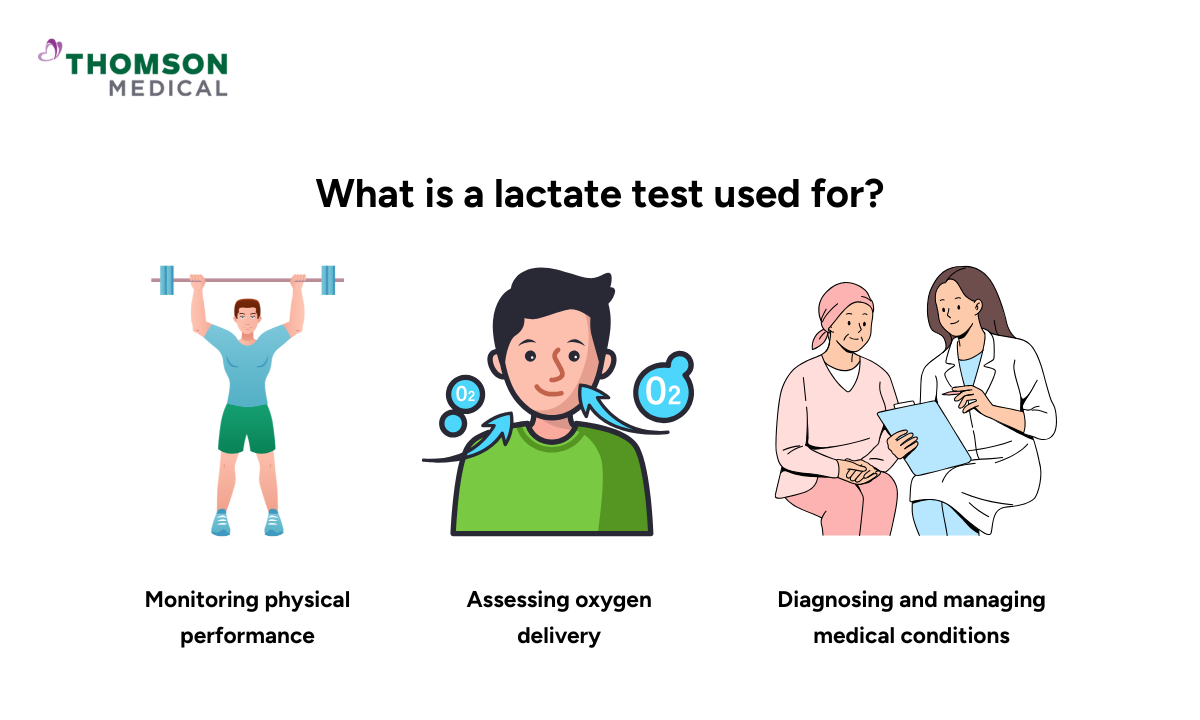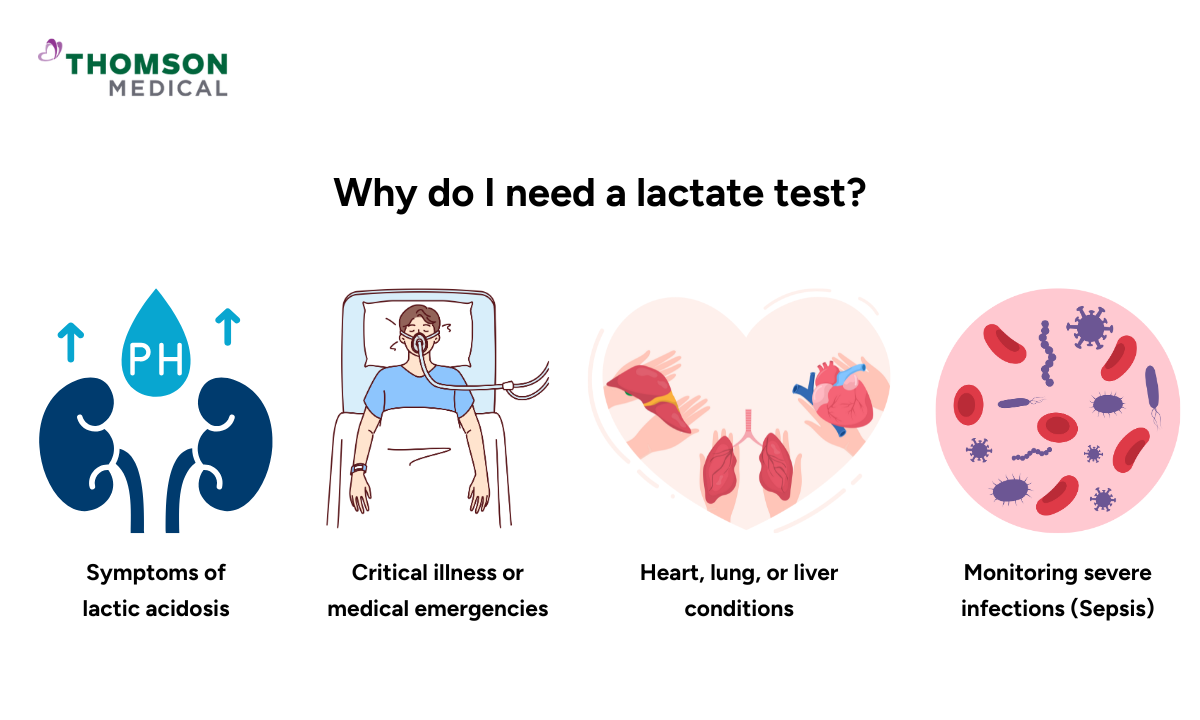What is a lactate test?
A lactate test is a blood test that measures the amount of lactate—also known as lactic acid—in your bloodstream. Lactate is a substance produced by your body during anaerobic metabolism, which happens when your cells generate energy without using oxygen. This process leads to lactate production, especially when oxygen levels are low.
This process commonly occurs during intense physical activity or when there’s a lack of oxygen due to certain medical conditions. Monitoring lactate levels helps doctors assess how well your body is using oxygen and can aid in diagnosing serious health issues such as sepsis, shock, or heart failure.
What is a lactate test used for?

A lactate blood test is used to evaluate how effectively your body uses oxygen, especially during physical stress, illness, or intense exercise. It serves several important purposes:
Monitoring physical performance:
In sports and fitness, lactate measurements during or after intense exercise help assess endurance, training intensity, and how efficiently the body clears lactate.
Assessing oxygen delivery:
High levels of lactate can signal that the body’s tissues lack oxygen, which may happen in critical conditions such as shock, severe infections (sepsis), or respiratory failure.
Diagnosing and managing medical conditions:
The test helps detect lactic acidosis—a dangerous build-up of lactic acid levels in the blood—linked to health problems like heart failure, liver disease, uncontrolled diabetes, or severe infections.
Lactate testing is commonly performed in emergency or intensive care units to monitor patients in critical condition and guide urgent treatment decisions.
Why do I need a lactate test?

A lactate test may be necessary if your doctor suspects a problem with how your body is using oxygen or managing energy. Some common reasons for needing this test include:
Symptoms of lactic acidosis:
If you’re experiencing signs such as rapid breathing, muscle weakness, nausea, confusion, or unusual fatigue, the test can help identify whether elevated lactate is the cause.
Critical illness or medical emergencies:
If you’re in a hospital’s emergency or intensive care unit, the test helps doctors assess how well your body is delivering oxygen to tissues and how your metabolism is responding to stress.
Heart, lung, or liver conditions:
Chronic or acute diseases affecting these organs can impair oxygen delivery or lactate clearance, leading to elevated levels.
Monitoring severe infections:
In cases of serious bacterial infections like sepsis, tracking lactate levels helps evaluate disease severity and guide urgent treatment.
If you’re experiencing any of these symptoms or have concerns about your oxygen levels or metabolic health, request an appointment with us to evaluate whether a lactate test is right for you. Early detection can make a life-saving difference.
Preparing for a lactate test
In most cases, no special preparation is needed before a lactate test. However, to ensure accurate results, keep the following in mind:
Fasting:
You may be asked to fast if the test is part of a broader metabolic screening, but fasting is not typically required for a lactate test alone.
Avoid strenuous exercise:
Refrain from intense physical activity before the test, as it can temporarily raise the level of lactate and lead to misleading results.
Medication disclosure:
Let your healthcare provider know about any medications or supplements you’re taking. Certain drugs—such as metformin or alcohol—can influence lactate levels and may need to be considered during interpretation.
What happens during a lactate test?
Basically, a lactate test is a quick and simple procedure that involves collecting a small blood sample. Here’s what you can expect:
Blood draw:
A healthcare professional will take a blood sample, usually from a vein in your arm. In some cases—especially in emergency or critical care settings—the sample may be taken from an artery.
Laboratory analysis:
The blood sample is sent to a laboratory, where it is analysed to determine the lactate concentration in your blood.
Alternative testing:
In urgent situations, measurement of lactate levels can be part of a blood gas test, which provides additional information about oxygen and acid-base balance in your body.
The test typically takes only a few minutes and helps provide important insights into your metabolic and oxygen status.
What do lactate test results mean?
Lactate test results help indicate how well your body is producing and clearing lactic acid. Here’s how to interpret the typical findings:
Normal lactate levels
Generally range from 0.5 to 2.2 mmol/L (millimoles per litre). This level indicates healthy oxygen use and metabolic function.
High lactate levels (2.3 – 4.9 mmol/L)
These results may suggest that your tissues are not receiving enough oxygen or that your body is under physical or metabolic stress. Some possible causes include:
Lactic acidosis:
A serious condition often linked to sepsis, shock, severe hypoxia, or kidney failure.
Strenuous anaerobic exercise:
Intense physical activity can cause a temporary rise in lactate.
Heart or respiratory failure:
These conditions can impair oxygen delivery to tissues, raising lactate levels.
Metabolic disorders:
Problems affecting the liver, muscles, or red blood cells can disrupt lactate processing.
Viral meningitis:
Inflammation of the brain and spinal cord membranes can affect oxygenation and metabolism, potentially increasing lactate levels.
If your lactate test was performed using cerebrospinal fluid (CSF), high lactate levels are more commonly associated with bacterial meningitis rather than viral meningitis.
Very high lactate levels (≥ 5.0 mmol/L)
This is a critical level that may indicate lactic acidosis, a serious condition that can occur in life-threatening situations. Immediate medical intervention is often necessary.
Price of a lactate test in Singapore
The cost of a lactate test in Singapore can vary depending on the healthcare provider, setting (public vs private), and whether additional tests are ordered at the same time.
Public hospitals and polyclinics: Prices typically range from S$10 to S$40, excluding consultation and other laboratory fees.
Private clinics and hospitals: The test may cost between S$50 and S$100, depending on the facility and whether urgent processing is required.
Health screening packages: In some cases, a lactate test may be included as part of a broader metabolic or fitness-related screening, which could influence the total price.
It's best to contact your healthcare provider or clinic directly to confirm the latest pricing, especially if you're using insurance or paying out of pocket.
The information provided above is intended for general reference only. For detailed fee information and payment options, please consult your healthcare provider directly. Request an appointment with our specialists at Thomson Medical today for a detailed price breakdown and a personalised care plan.
FAQ
What is a lactate test used for?
A lactate test is used to detect lactic acidosis, evaluate the delivery of oxygen to the body’s tissues, and monitor metabolic conditions like shock, sepsis, respiratory failure, or the effects of intense exercise.
Are there any risks to the lactate test?
A lactate test is very safe. Minor risks from the blood sample draw include slight bruising, swelling, dizziness, or, rarely, infection at the puncture site.
What is a normal lactate level?
A normal lactate range usually falls between 0.5 and 2.2 mmol/L. Levels above this range may suggest oxygen deficiency, metabolic stress, or an underlying medical condition.
What does a high lactate level indicate?
A high lactate level may indicate lactic acidosis, often linked to conditions such as sepsis, shock, intense exercise, heart or lung failure, or metabolic disorders. It signals that the body’s tissues may not be receiving or using oxygen effectively.
Why is lactate a marker for sepsis?
Lactate is a marker for sepsis because it indicates poor transport of oxygen to tissues. In sepsis, reduced blood flow causes cells to produce excess lactate, signalling tissue hypoxia and increased risk of organ failure.
If blood lactate levels are above the normal range, treatment is usually started immediately—even before a confirmed diagnosis—because early intervention greatly improves the chances of recovery.
What is the role of lactate in the body?
Lactate plays a key role in energy production, especially during intense exercise or low oxygen conditions. It is produced by muscle cells when the body breaks down glucose without enough oxygen (anaerobic metabolism). Lactate can then be reused by the liver and muscles as a valuable fuel source, helping to maintain energy levels during physical exertion.
What are the signs of too much acid in your body?
Signs of excessive acid in the body (acidosis) include:
Rapid breathing (as your body tries to expel excess carbon dioxide)
Fatigue or weakness
Confusion or dizziness
Nausea and vomiting
Muscle pain or cramps
These symptoms may indicate a serious imbalance and require medical attention.
How can you reduce high lactate levels?
To lower elevated lactate levels, it’s important to address the underlying cause. This may include:
Improving oxygen delivery by treating conditions like heart failure, sepsis, or respiratory issues
Staying hydrated to help remove excess lactate from the body
Resting and recovering if levels are elevated due to intense exercise
Managing metabolic disorders such as diabetes or liver disease through appropriate medical care
You should always consult a healthcare professional for proper diagnosis and treatment.
Can I lower my lactate levels naturally?
While there’s no direct way to lower lactate levels instantly, they often improve once the underlying cause is treated. For example, managing chronic conditions like diabetes or liver disease, avoiding substances like alcohol, and treating infections or shocks can help normalise lactate levels over time. If the rise is a temporary condition—due to intense exercise or acute illness—it usually resolves on its own with rest and recovery. Always follow your doctor’s advice to address the root cause and support healthy metabolic function.
The range of services may vary between Thomson clinic locations. Please contact your preferred branch directly to enquire about the current availability.
The information provided is intended for general guidance only and should not be considered medical advice. For personalised recommendations and tailored advice, please consult a specialist at Thomson Medical. Request an appointment with Thomson Medical today.
For more information, contact us:
Thomson Specialists Paragon (Health Screening)
- Mon - Fri: 8.30am - 5.30pm
- Sat: 8.30am - 12.30pm
Call: 6735 0300
See Health Screening Packages
Notice:
The range of services and tests may vary. Please contact us directly to enquire about the current availability.
Book Health Screening